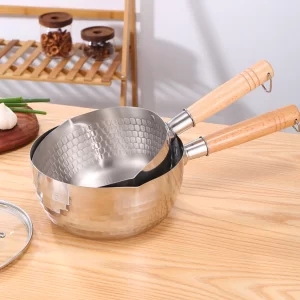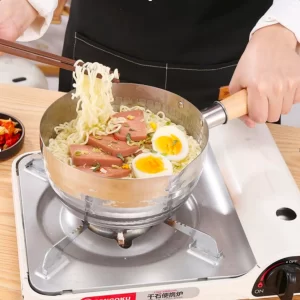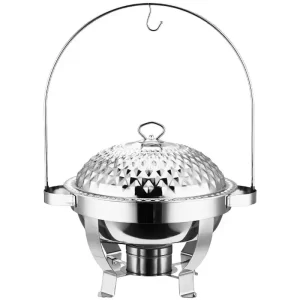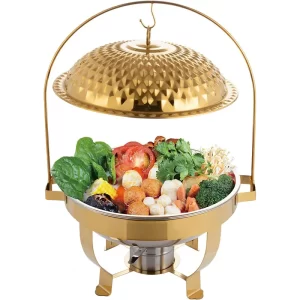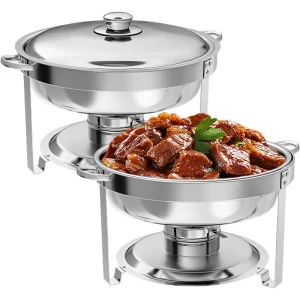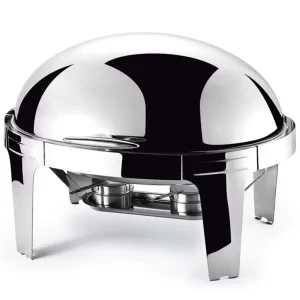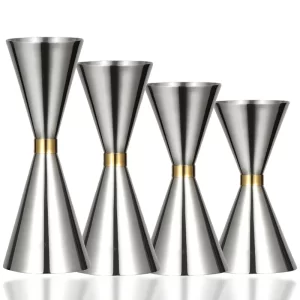As a traditional and modern kitchen tool, the stainless steel Yukihira saucepan has many social applications. It not only holds an irreplaceable position in home kitchens, but is also widely used in many public catering facilities such as the catering industry, hotels, restaurants, hospitals, and schools. With the rise of the healthy diet trend, more and more consumers are concerned about the health and safety of stainless steel cookware, especially those with unclear chemical coatings or those that may release harmful substances. Stainless steel Yukihira pots have become the first choice for many household and commercial kitchens due to their natural material.
About Yukihira Saucepan’s History
The history of the stainless steel Yukihira saucepan is closely related to its traditional form and application. Although stainless steel itself was widely used as a material only in the early 20th century, the roots of the snow peak pot can be traced back to the traditional cooking utensils in ancient Japan.
Yukihira-nabe (Japanese: snow flat pot, yukihira-nabe) originated in Japan. It is a kind of pot with a shallow bottom, wide mouth, and slightly concave edge. It is widely used in Japanese homes and kitchens. Its design originated from early copper, aluminum, or iron pots and is usually used in cooking methods with a lot of liquid, such as stewing, making soup, and stewing vegetables.
The invention of stainless steel emerged approximately in the early 20th century (stainless steel was discovered by Harry Brearley of the United Kingdom in 1913). Before that, snow flat pans were mainly made of materials such as copper, aluminium, and iron. Because these materials are relatively prone to rust and have a shorter service life, the introduction of stainless steel has changed the material of cookware. Especially for kitchen tools, stainless steel has better durability, corrosion resistance, and ease of cleaning. The design of modern stainless steel snow flat pans has become more user-friendly, featuring anti-scald handles, a measuring cup scale, and a more refined shape design, making the user experience more comfortable and convenient.
The hot sales of stainless steel snow flat pans are mainly concentrated in regions such as Japan, South Korea, China, the United States, Europe, Australia, and Southeast Asia. Its sales growth is mainly attributed to the internationalization of Japanese cuisine, the increasing demand for high-quality kitchenware from consumers, and the excellent quality and adaptability of the snow flat pan itself. With the global focus on healthy cooking, environmental protection,n and durable products, the market potential of snow flat pans remains huge.
The Size of Yukihira’s Pot
The Advantage of the Yukihira Saucepan
Strong durability
Stainless steel is very strong and has extremely high durability. Compared with aluminum or iron pots, stainless steel snow flat pots are less likely to deform, get damaged, or rust and can be used for a long time. This makes it kitchenware with a high return on investment, especially suitable for daily cooking and large-scale cooking needs.
Corrosion resistance
Stainless steel is a material with good corrosion resistance. Even if exposed to acidic or alkaline foods for a long time, stainless steel cookware is not prone to rust or corrosion. This is very important for making soups, stews, hot POTS, and other dishes with a lot of liquid, which can ensure that the cookware can be used for a long time without affecting the taste of the food.
Applicable to a variety of stoves
Stainless steel Yukihira saucepans are suitable for various heat sources, including gas stoves, induction cookers, electric ceramic stoves, etc. This makes it very flexible. Whether it is a home kitchen or a commercial kitchen, it can be used conveniently with almost no restrictions on equipment.
Heat resistance
Stainless steel cookware can withstand high temperatures and is highly suitable for high-temperature cooking, such as stir-frying, deep-frying, and boiling soups. It can heat up rapidly and can be used at high temperatures continuously without deformation. This makes the stainless steel snow flat pan very suitable for dishes that require a long time to boil or heat.
Anti-overflow design
The texture designed on the surface of the snow flat pan can guide the liquid flow more effectively. When the liquid in the pot generates foam due to boiling or stirring, the slight concave effect on the edge of the pot helps to limit the overflow of the liquid and prevent the overflowing foam from flowing out along the pot opening.
Non-toxic and healthy
Stainless steel itself does not release harmful substances and is a safe cooking material. Compared with some coated cookware (such as non-stick pans), stainless steel Yukihira pans contain no chemical coatings and will not release harmful gases or substances due to high temperatures. Therefore, it is regarded as a healthier cooking option, especially for people who pay attention to a healthy diet.
The Production Process of the Yukihira Saucepan
The production process of stainless steel Yukihira sauce pan involves multiple steps, including mold design and opening, material stamping, stretching and forming, heating and hardening treatment, surface treatment, installation of accessories, quality inspection, packaging, etc. The entire production process requires high-precision craftsmanship to ensure the durability, functionality and aesthetics of the cookware.
Design and mold opening: Use computer-aided design (CAD) software to conduct detailed design of the cookware, determine all specifications of the cookware, and make molds based on the design drawings
Material stamping: First, select the appropriate thickness from the stainless steel coil. Different styles of cookware may use stainless steel materials of different thicknesses. Use a press to press the stainless steel materials into discs of corresponding sizes.
Stretching forming: The stamped stainless steel sheet is placed in the mold, and pressure is applied through a hydraulic press to gradually deform the stainless steel round sheet, forming the bottom, side walls and edges of the pot. At this point, the basic outline of the pot has taken shape.
Heating and hardening treatment: Through quenching (rapid cooling) and annealing (slow heating) processes, the physical properties of the cookware are brought to the best state.
Surface treatment: The surface texture of the snow flat pot is formed by a rolling machine, and then polished
Installation accessories: Weld the handle
Quality inspection: Check the surface of the cookware for scratches, cracks or other defects to ensure that the appearance meets the quality standards.
Packaging: Packaging is carried out according to customer requirements and transportation needs
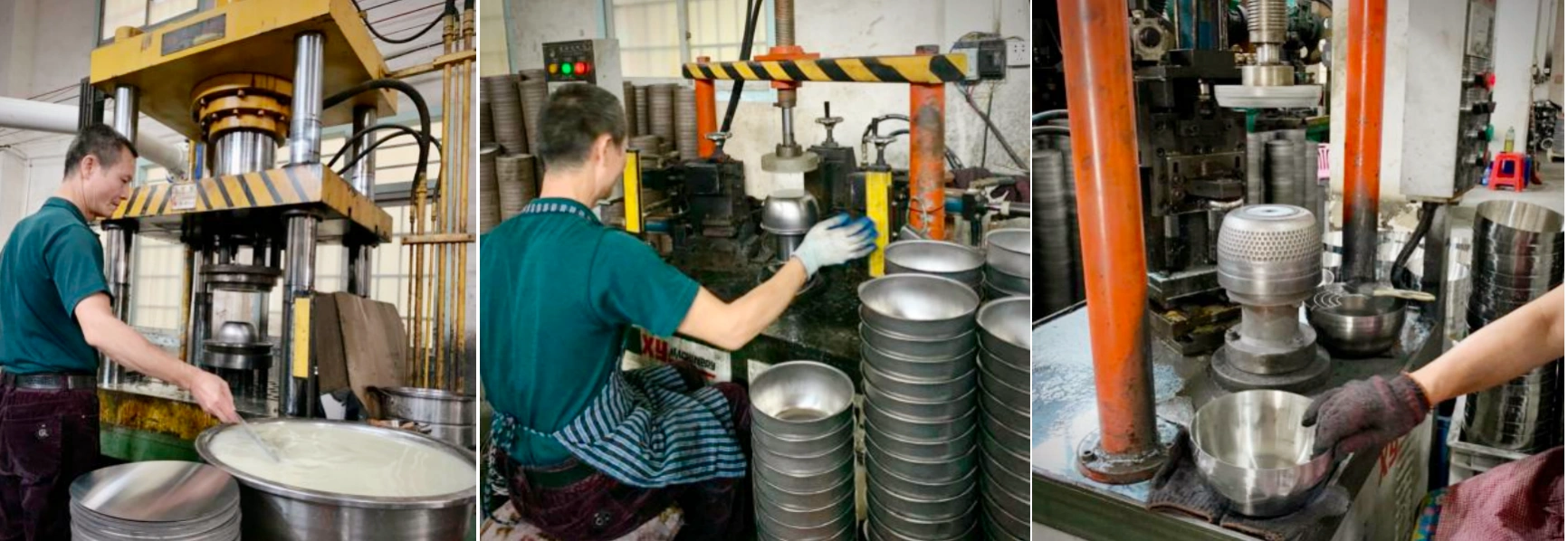
Contact Us
Yongyu has 25 years of rich industry experience and is dedicated to providing high-quality production and customization services for stainless steel snow flat pans. If you have any cooperation needs, please feel free to contact us anytime. We will wholeheartedly provide you with the best solution, strictly control the quality, and deliver on time. Whether you are a large retailer, distributor, or a small business, we offer flexible cooperation models. From bulk wholesale to small-batch customization, we can provide you with the most suitable cooperation plans to meet the needs of businesses of different scales.


